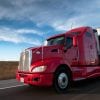Whenever you get in your car, chances are that you’ll share a stretch of road with a tractor-trailer or other large trucks. These trucks account for a significant number of the vehicle miles driven each year – and their large size, weight, and other factors make them a big danger in an accident.
To drive safely around large trucks, it helps to understand the road from the truck driver’s perspective. Here’s a glimpse into what it’s like to navigate one of these massive vehicles – and what you can do, as a driver, to make sure truckers can get around safely.
- They can’t see as well as you do.
Trucks have multiple blind spots, and those blind spots are big enough to fit a passenger vehicle inside. Both sides of the truck, as well as the space immediately in front of or behind the truck, are “blind” to the driver. Although the truck’s mirrors help, they aren’t the same as being able to look out the window.
- Their stopping distance is much longer than yours.
A fully-loaded tractor-trailer may weigh up to 80,000 pounds. When that weight is traveling at 65 miles per hour, it generates a lot of momentum – which means it needs a lot more space to slow down and stop. A truck might need up to 200 yards, or the length of two football fields, to come to a complete stop. And, since a truck’s brakes are powered by air, “stomping” the brake for a quick slowdown or maneuver simply isn’t an option.
- They’re vulnerable to high winds.
Most passenger vehicles are about five or six feet tall, and they’re designed to be aerodynamic, to improve gas mileage and cut down on wind “shear.” Large trucks, however, are thirteen feet tall – and they’re basically big boxes. As a result, trucks are harder to control in a high wind.
- They make much wider turns than you might expect.
Thanks to their size and their pivot points, trucks need to make very wide turns, especially when they are turning right. Luckily, there’s an easy way to make sure you’re out of a truck’s way in an intersection: always stop behind the white line. Truck drivers aim for the edge of this line when they turn, so if you’re behind it, you’ll nearly always be out of the way.
